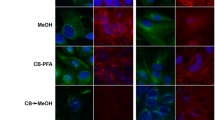Summary
When the compound eyes of the fly Lucilia are fixed for electron microscopy with glutaraldehyde in common buffer solutions, artefactual whorls are liable to be formed from the photoreceptor microvilli. The whorls result from two factors: (i) a prolonged time interval prior to osmication, such as the “overnight” primary fixation or wash at 4° C commonly used in studies of compound eyes; (ii) as little as 1–2 mM Ca++ in the primary fixative and wash solutions. Osmication after short (1 h) glutaraldehyde fixation at 4° C, or omission of Ca++ and addition of 2 mM EGTA, prevent whorl-formation. In the tipulid fly Ptilogyna, similar artefacts are produced, but are confined to the distal zone of the microvilli that sheds during turnover.
Similar content being viewed by others
References
Bodian D (1970) An electron microscopic characterization of classes of synaptic vesicles by means of controlled aldehyde fixation. J Cell Biol 44:115–124
Bowes JH, Cater CW (1966) The reaction of glutaraldehyde with proteins and other biological materials. J R Microsc Soc 85:193–200
Eguchi E, Waterman TH (1979) Longterm dark induced fine structural changes in crayfish photorecetor membrane. J Comp Physiol 131:191–203
Franke WW, Krien S, Brown RM (1969) Simultaneous glutaraldehyde-osmium tetroxide fixation with postosmication. An improved fixation procedure for electron microscopy of plant and animal cells. Histochemie 19:162–164
Karnovsky MJ (1965) A formaldehyde-glutaraldehyde fixative of high osmolarity for use in electron microscopy. J Cell Biol 27:137A-138A
Korn ED (1967) A Chromatographic and spectrophotometric study of the products of the reaction of osmium tetroxide with unsaturated lipids. J Cell Biol 34:627–638
Millonig G (1962) Further observations on a phosphate buffer for osmium solutions in fixation. In: Breese SS (ed) Proceedings of the Fifth International Congress for Electron Microscopy. Vol 2 Academic Press, New York
Papahadjopoulos D, Vail WJ, Jacobson K, Poste G (1975) Cochleate lipid cylinders: formation by fusion of unilamellar lipid vesicles. Biochim Biophys Acta 394:483–491
Reynolds ES (1963) The use of lead citrate at high pH as an electron-opaque stain in electron microscopy. J Cell Biol 17:208–212
Roach JLM, Wiersma CAG (1974) Differentiation and degeneration of crayfish photoreceptors in darkness. Cell Tissue Res 153:137–144
Sabatini DD, Bensch K, Barrnett RJ (1963) Cytochemistry and electron microscopy. The preservation of cellular ultrastructure and enzymatic activity by aldehyde fixation. J Cell Biol 17:19–58
Trujillo-Cenóz O, Melamed J (1966) Electron microscopy observations on the peripheral and intermediate retinae of dipterans. In: Bernhard CG (ed) The functional organization of the compound eye. Pergamon Press, London
Trump BF, Bulger RE (1966) New ultrastructural characteristics of cells fixed in a glutaraldehyde tetroxide mixture. Lab Invest 15:368–379
Trump BF, Ericsson JLE (1965) The effect of the fixative solution on the ultrastructure of cells and tissues. A comparative analysis with particular attention to the proximal convoluted tubule of the rat kidney. Lab Invest 14:1245–1323
Williams DS (1980) Organisation of the compound eye of a tipulid fly during the day and night. In preparation
Williams DS, Blest AD (1980) Extracellular shedding of photoreceptor membrane in the open rhabdom of a tipulid fly. Cell Tissue Res. 205, 423–438 (1980)
Author information
Authors and Affiliations
Rights and permissions
About this article
Cite this article
Williams, D.S. Ca++-induced structural changes in photoreceptor microvilli of diptera. Cell Tissue Res. 206, 225–232 (1980). https://doi.org/10.1007/BF00232766
Accepted:
Issue Date:
DOI: https://doi.org/10.1007/BF00232766




